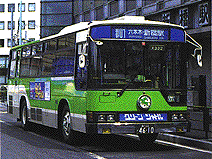 Science & Technology || Search|| Back Numbers CUTTING THE ENGINE: "Stop Idling" Campaign Gathers Momentum March 11, 1998 
Bus companies are at the forefront of the campaign to reduce wasteful idling. (Photo: Transportation Bureau, Tokyo Metropolitan Government) The "stop idling" movement, which calls for engines to be turned off in stationary vehicles, is gaining ground, particularly among commercial drivers. The movement aims to reduce air pollution and global warming by controlling emission of exhaust gases such as carbon dioxide, and also to contribute to energy conservation and and noise pollution reduction. The Environment Agency began a campaign against idling about six months ago, which includes the distribution of pamphlets and stickers. An increasing number of local governments have recently instituted regulations against idling, and driver awareness of this issue is also on the rise. Global Warming and Energy Conservation Go Hand in Hand Many people leave their car engines running without any thought while they get in and out of their cars, go shopping, and load or unload baggage; but few of them recognize the massive benefits turning off engines in these instances would have for global warming and energy conservation. According to studies from the Environment Agency and the automobile industry, a car's engine idling for 10 minutes produces about 90 grams of carbon dioxide and consumes 0.14 liters of fuel. If all the approximately 68.6 million cars owned in Japan were left to idle for 10 minutes, they would spew out 6,170 tons of carbon dioxide and consume as much as 9.6 million liters of fuel. Conversely, if all cars left their engines running for a minute less each day--or 365 minutes less a year--about 225,200 fewer tons of carbon dioxide would be emitted, and 350 million liters of energy saved. Even assuming each car is used only 200 days per year, this measure would bring about a 123,400-ton drop in carbon dioxide emissions and 192 million liters in fuel savings. Because of these considerations, agencies including the Ministry of
Transport have been appealing to drivers against wasteful idling for
several years. The Environment Agency took the opportunity to inaugurate
its campaign during the so-called environment month of June 1997, which
preceded Kyoto's December 1997 hosting of COP3--the Third Session of the
Conference of the Parties to the U.N. Framework Convention on Climate
Change. The agency distributed pamphlets detailing idling's detrimental
effects on the environment to concerned industrial groups and local
governments, and distributed large quantities of "stop idling" stickers to
be posted on trucks and taxis. In this way, the movement's scope has been
increased.
At first, bus passengers complained about clumsy driving as engines seemed to stall repeatedly, but as operators have gotten the word out with stickers and other measures, understanding of the issue has begun sinking in. Furthermore, an increase has been noted in the number of bus companies that have not implemented the aforementioned device ordering drivers to stop their engines when stationary anyway. A private railway company in Kyushu is using banners displayed at its office and stickers on buses to educate drivers about turning off engines in stationary vehicles. In the trucking industry, a scheme has taken root where the ignition key
is tied to the driver's belt with a piece of string in order to keep
drivers from leaving the engine running when they get out. Since June 1997,
industry players have been distributing string and stickers to their
employees throughout Japan, and there is a further plan to appeal to
drivers by means of radio commercials.
In Tokyo, for example, an appeal to cut down on idling during the winter months from November to January, when air circulation is poor, began in 1995. In January 1998, Tokyo conducted the nation's first survey on idling, including all cars parked on roads or in lots in shopping areas, office, and residential districts. The metropolitan government is acting on the survey results and moving quckly to enact legislation on this problem. However, it is extremely difficult to quantify the effect of such regulations, and to date no punishment has been meted out for an infraction of an idling-related ordinance. Even so, it seems, the invisible results of these regulations are far from negligible. For example, it has been observed in Kyoto Prefecture that the transportation industry is more willing to cooperate in curbing idling if requests are grounded in law. In Hyogo Prefecture, the benefits of not idling are coming to be understood by drivers at large, and it is hoped anti-idling education will have greater positive effects. One private organization promoting the "stop idling" campaign is appealing to drivers of private cars to switch off their car engines if they expect to be stationary for one minute or more in gasoline-run cars, or for 20 seconds or more in diesel-run cars. Car batteries with greater capacity and highly durable motors are necessary if engines are to be turned off frequently while drivers wait for traffic lights to change or traffic jams to ease, but the private-use cars currently on the road are not designed for this type of use. In the end, the environment will benefit not only from a reduction in wasteful idling, but from common-sense driving techniques: maintaining suitable tire pressure, not carrying unnecessary loads, using the air-conditioning economically, and refraining from sudden acceleration and high speed.  Edited by Japan Echo Inc. based on domestic
Japanese news sources. Articles presented here are offered for reference
purposes and do not necessarily represent the policy or views of the Japanese
Government. Edited by Japan Echo Inc. based on domestic
Japanese news sources. Articles presented here are offered for reference
purposes and do not necessarily represent the policy or views of the Japanese
Government.
|
